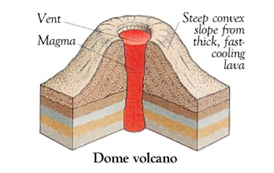World Volcanos


World Ocean
January 11, 2020

World Lakes
January 17, 2020A volcano is a mountain that has lava (hot, liquid rock) coming out from a magma chamber under the ground, or that has had that in the past.
Volcanoes are formed by the movement of tectonic plates.When pressure builds up, eruptions occur.
In an eruption, gases and rock shoot up through the opening and spill over or fill the air with lava fragments. Eruptions can cause lava flows, hot ash flows, mudslides, avalanches, falling ash and floods.
How does the inside of a volcano look like?


| Parts | Description |
|---|---|
| The magma chamber | This is the area with massive collection of magma below the earth’s crust from which magma flows out. |
| Crater | After an eruption, the tip or top of the volcano tends to get blown off, leaving a small depression at the top of it. |
| Main vent | This is the main exit point (opening or outlet) in a weak zone where molten magma is released to the surface. |
| Secondary vents | These are other smaller vents or opening through which ash and gases and lava escape. |
| Ashes, clouds and cinders | As the eruption continues, ashes and gases are discharged into the air, which is carried further by wind action. |
| Layers of ash and lava | The walls of a volcano are usually made up of solidified layers of lava and dust. |
Common types of volcanoes:
| Types of volcanoes | Description |
|---|---|
  |
1. This has very fluid lava, usually from multiple vents or fractures, spreading over very large areas. 2. The result is usually an elevation with a shape like a warrior’s shield. 3. E.g. Mount Kilauea, Maunaloa |
  |
1. They are produced from eruptions with less viscous lava. 2. Lava domes tend to have steep walls and rock types. |
  |
1. When lava is ejected into the air above, the fragments and fine particles fall as cinders (ash) around the vent, forming a cone. 2. E.g. The Paricutin Volcano |
  |
1. These are usually awesome in nature, rising up to about 8000ft. 2. E.g. Mount Cotopaxi, Mount Fuji |
Some of the Active Volcanoes:
| Name of volcano | Description |
|---|---|
  |
Location: Hawaii, USA Continuous eruption: From 1983 Explosivity Index: 4 |
  |
Location: Sicily, Italy Continuous eruption: 3,500 years Explosivity Index: 5 |
  |
Location: La Réunion Island (French) Continuous eruption: From 1920 Explosivity Index: 5 |
  |
Location: Stromboli, Italy Continuous eruption: 2,000 years Explosivity Index: 3 |
  |
Location: Tanna Island, Vanuatu Continuous eruption: 800 years Explosivity Index: 3 |
  |
Location: Ambrym Island, Vanuatu Continuous eruption: From 1935 Explosivity Index: 6+ |
  |
Location: Indonesia Continuous eruption: From 1967 Explosivity Index: 4 |
  |
Location: Ethiopia Continuous eruption: From 1967 Explosivity Index: 1 |
  |
Location: Guatemala Continuous eruption: From 1965 Explosivity Index: 3 |
  |
Location: Antarctica Continuous eruption: From 1972 Explosivity Index: 4 |
Effects of Volcanoes:
- Volcanic gases: Water vapor is typically the most abundant volcanic gas, followed by carbon dioxide, sulphur dioxide, hydrogensulphide, hydrogen chloride, and hydrogen fluoride.
- Acid rain: Gas emissions from volcanoes are a natural contributor to acid rain. Volcanic activity releases about 130 to 230 teragrams of carbon dioxide each year.
- Hazards: Ash thrown into the air by eruptions can present a hazard to aircraft, especially jet aircraft where the particles can be melted by the high operating temperature; the melted particles then adhere to the turbine blades and alter their shape, disrupting the operation of the turbine.
Interesting Facts:
- The word volcano originally comes from the name of the Roman god of fire, Vulcan.
- While most volcanoes form near tectonic boundaries, they can also form in areas that contain abnormally hot rock inside the Earth known as mantle plumes. These hotspots are found at a number of locations around the globe with the most notable being in Hawaii.
- While we certainly have some big volcanoes here on Earth, the biggest known volcano in our solar system is actually on Mars.
- The object with the most volcanic activity in our solar system is Io, one of Jupiter’s moons. Covered in volcanoes, its surface is constantly changing to the large amount of volcanic activity.
- Volcanic eruptions can send ash high into the air, over 30km (17 miles) above the Earth’s surface.
- Large volcanic eruptions can reflect radiation from the Sun and drop average temperatures on Earth by around half a degree.





